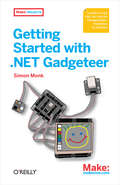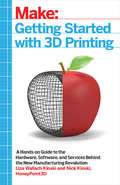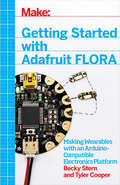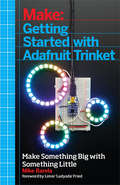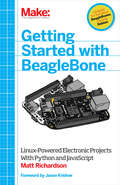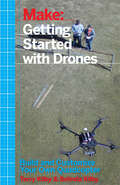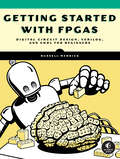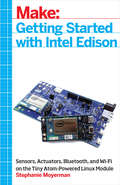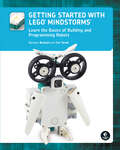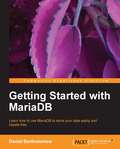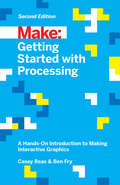- Table View
- List View
Getting Started with .NET Gadgeteer: Learn to Use This .NET Micro Framework-Powered Platform
by Simon MonkLearn how to quickly build cool electronic gadgets with .NET Gadgeteer. With the easy-to-follow instructions in this guide, you’ll tackle five fascinating projects, using Microsoft’s rapid prototyping Gadgeteer platform. There’s no soldering involved—you simply plug in modules that make gadget-building quick and easy.Ideal for beginners, this book shows you how to work with modules and other hardware in the popular Fez Spider Starter Kit, and teaches you how to program your gadgets with Visual Studio C# Express and the .NET Micro Framework 4.1 SDK. You’ll soon learn a wide range of programming techniques along with the skills to design your own projects.Get to know the software and hardware with a simple LED projectDownload code from the companion site to build and test each projectBuild a spy camera that automatically captures and saves images at regular intervalsConstruct a simple animated game with the joystick moduleCreate a web server that sends messages you draw or write on the touchscreen moduleBuild a gadget that backs up digital images from an SD card to a USB flash driveLearn about other .NET Gadgeteer modules for creating environmental sensors, an MP3 player, and a WiFi network
Getting Started with 3D Carving: Five Step-by-Step Projects to Launch You on Your Maker Journey
by Zach Kaplan3D printing has been the hot topic in the maker world for years now, but there's another type of desktop manufacturing that's become the go-to choice for anyone who needs durable results fast. Instead of slowly depositing layers of plastic, a 3D carver starts with a solid block of material and carves it away using a rotating metal bit. It's faster than 3D printing, offers a wider choice of materials, and creates durable, permanent parts that look great. This book covers the basics of designing and making things with a 3D carver, and gives you several projects you can build yourself including a guitar, clock, earrings, and even a skateboard.
Getting Started with 3D Printing
by Liza Wallach Kloski Nick KloskiThe book is written in a casual, conversational style. It is easily accessible to those who have no prior knowledge in 3D printing, yet the book's message is solidly practical, technically accurate, and consumer-relevant. The chapters include contemporary, real-life learning exercises and insights for how to buy, use and maintain 3D printers. It also covers free 3D modeling software, as well as 3D printing services for those who don't want to immediately invest in the purchase of a 3D printer. Particular focus is placed on free and paid resources, the various choices available in 3D printing, and tutorials and troubleshooting guides.
Getting Started with 3D Printing: A Hands-on Guide to the Hardware, Software, and Services Behind the New Manufacturing Revolution
by Liza Wallach Kloski Nick KloskiMake: Getting Started with 3D Printing is a practical, informative, and inspiring book that guides readers step-by-step through understanding how this new technology will empower them to take full advantage of all it has to offer. The book includes fundamental topics such as a short history of 3D printing, the best hardware and software choices for consumers, hands-on tutorial exercises the reader can practice for free at home, and how to apply 3D printing in the readers' life and profession. For every maker or would-be maker who is interested, or is confused, or who wants to get started in 3D printing today, this book offers methodical information that can be read, digested, and put into practice immediately!
Getting Started with Adafruit Circuit Playground Express: The Multipurpose Learning and Development Board with Built-In LEDs, Sensors, and Accelerometer
by Anne BarelaFrom Adafruit Industries, a leader in products to Makers, designers, students young and old, comes the Circuit Playground Express. Connect it to your PC, Mac or Linux computer, and you can be programming interactive projects in minutes. You have a choice of programming environments to choose from: Python, the Microsoft MakeCode graphical building block environment, C/C++ via the Arduino development environment and JavaScript. Whether you are learning interactive programming, have an Internet of Things project in mind, or are looking to design on-the-go wearable electronics, the versatile Circuit Playground Express is the device to start with. In Getting Started with the Adafruit Circuit Playground Express, you'll learn how to:Get up and running quickly with programmable boardsUnderstand the basics of coding in multiple programming languagesUse the built-in sensors for a variety of projectsMake colorful interactive displaysDesign programs for the Internet of Things (IoT)
Getting Started with Adafruit FLORA: Making Wearables with an Arduino-Compatible Electronics Platform
by Tyler Cooper Becky SternThis book introduces readers to building wearable electronics projects using Adafruit's tiny FLORA board: at 4.4 grams, and only 1.75 inches in diameter, and featuring Arduino compatibility, it's the most beginner-friendly way to create wearable projects. This book shows you how to plan your wearable circuits, sew with electronics, and write programs that run on the FLORA to control the electronics. The FLORA family includes an assortment of sensors, as well as RGB LEDs that let you add lighting to your wearable projects.
Getting Started with Adafruit Trinket: 15 Projects with the Low-Cost AVR ATtiny85 Board
by Mike BarelaArduino's ubiquity and simplicity has led to a gigantic surge in the use of microcontrollers to build programmable electronics project. Despite the low cost of Arduino, you're still committing about $30 worth of hardware every time you build a project that has an Arduino inside. This is where Adafruit's Trinket comes in. Arduino-compatible, one-third the price, and low-power, the Trinket lets you make inexpensive and powerful programmable electronic projects. Written by one of the authors of Adafruit's Trinket documentation, Getting Started with Trinket gets you up and running quickly with this board, and gives you some great projects to inspire your own creations.
Getting Started with Arduino: The Open Source Electronics Prototyping Platform (Make: Projects)
by Massimo BanziThis valuable little book offers a thorough introduction to the open-source electronics prototyping platform that's taking the design and hobbyist world by storm. Getting Started with Arduino gives you lots of ideas for Arduino projects and helps you get going on them right away. From getting organized to putting the final touches on your prototype, all the information you need is right in the book. Inside, you'll learn about:Interaction design and physical computingThe Arduino hardware and software development environmentBasics of electricity and electronicsPrototyping on a solderless breadboardDrawing a schematic diagramAnd more. With inexpensive hardware and open-source software components that you can download free, getting started with Arduino is a snap. To use the introductory examples in this book, all you need is a USB Arduino, USB A-B cable, and an LED.Join the tens of thousands of hobbyists who have discovered this incredible (and educational) platform. Written by the co-founder of the Arduino project, with illustrations by Elisa Canducci, Getting Started with Arduino gets you in on the fun! This 128-page book is a greatly expanded follow-up to the author's original short PDF that's available on the Arduino website.
Getting Started with BeagleBone: Linux-Powered Electronic Projects With Python and JavaScript
by Matt RichardsonMany people think of Linux as a computer operating system, running on users' desktops and powering servers. But Linux can also be found inside many consumer electronics devices. Whether they're the brains of a cell phone, cable box, or exercise bike, embedded Linux systems blur the distinction between computer and device. Many makers love microcontroller platforms such as Arduino, but as the complexity increases in their projects, they need more power for applications, such as computer vision. The BeagleBone is an embedded Linux board for makers. It's got built-in networking, many inputs and outputs, and a fast processor to handle demanding tasks. This book introduces you to both the original BeagleBone and the new BeagleBone Black and gets you started with projects that take advantage of the board's processing power and its ability to interface with the outside world.
Getting Started with CNC: Personal Digital Fabrication with Shapeoko and Other Computer-Controlled Routers
by Edward FordGetting Started with CNC is the definitive introduction to working with affordable desktop and benchtop CNCs, written by the creator of the popular open hardware CNC, the Shapeoko. Accessible 3D printing introduced the masses to computer-controlled additive fabrication. But the flip side of that is subtractive fabrication: instead of adding material to create a shape like a 3D printer does, a CNC starts with a solid piece of material and takes away from it. Although inexpensive 3D printers can make great things with plastic, a CNC can carve highly durable pieces out of a block of aluminum, wood, and other materials. This book covers the fundamentals of designing for--and working with--affordable ($500-$3000) CNCs.
Getting Started with Drones: Build and Customize Your Own Quadcopter
by Belinda Kilby Terry KilbyWant to make something that can fly? How about a flying robot? In this book, you'll learn how drones work, how to solve some of the engineering challenges a drone presents, and how to build your own--an autonomous quadcopter that you can build, customize, and fly. Your drone will be your eyes in the sky and in places where a human could never get to-much less fit!
Getting Started with Electronic Projects
by Bill PrettyThis book is aimed at hobbyists with basic knowledge of electronics circuits. Whether you are a novice electronics project builder, a ham radio enthusiast, or a BeagleBone tinkerer, you will love this book.
Getting Started with FPGAs: Digital Circuit Design, Verilog, and VHDL for Beginners
by Russell MerrickSkip the complexity and learn to program FPGAs the easy way through this hands-on, beginner-friendly introduction to digital circuit design with Verilog and VHDL.Whether you have been toying with field programmable gate arrays (FPGAs) for years or are completely new to these reprogrammable devices, this book will teach you to think like an FPGA engineer and develop reliable designs with confidence.Through detailed code examples, patient explanations, and hands-on projects, Getting Started with FPGAs will actually get you started. Russell Merrick, creator of the popular blog Nandland.com, will guide you through the basics of digital logic, look-up tables, and flip-flops, as well as high-level concepts like state machines. You&’ll explore the fundamentals of the FPGA build process including simulation, synthesis, and place and route.You&’ll learn about key FPGA primitives, such as DSP blocks and PLLs, and examine how FPGAs handle math operations and I/O.Code examples are provided in both Verilog and VHDL, making the book a valuable resource no matter your language of choice. You&’ll discover how to:Implement common design building blocks like multiplexers, LFSRs, and FIFOsCross between clock domains without triggering metastable conditions or timing errorsAvoid common pitfalls when performing mathTransmit and receive data at lightning speeds using SerDesWrite testbench code to verify your designs are workingWith this accessible, hands-on guide, you&’ll be creating your own functional FPGA projects in no time. Getting started with FPGAs has never been easier.
Getting Started with Intel Edison: Sensors, Actuators, Bluetooth, and Wi-Fi on the Tiny Atom-Powered Linux Module
by Stephanie MoyermanThe Intel Edison is a crowning achievement of Intel's adaptation of its technology into maker-friendly products. They've packed the dual-core power of the Atom CPU, combined it with a sideboard microcontroller brain, and added in Wi-Fi, Bluetooth Low Energy, and a generous amount of RAM (1GB) and flash storage (4GB). This book, written by Stephanie Moyerman, a research scientist with Intel's Smart Device Innovation Team, teaches you everything you need to know to get started making things with Edison, the compact and powerful Internet of Things platform. Projects and tutorials include: Controlling devices over BluetoothUsing Python and Arduino programming environments on EdisonTracking objects with a webcam and OpenCVResponding to voice commands and talking backUsing and configuring Linux on Edison
Getting Started with Intel Galileo: Electronic Projects with the Quark-Powered Arduino-Compatible Board
by Matt RichardsonGetting Started with the Intel Galileo gets you up and running with this new, x86-powered board that was developed in collaboration between Arduino and Intel. You'll learn how to set it up, connect it to your computer, and begin programming. You'll learn how to build electronics projects around the Galileo, and you'll explore the features and power that make it different from all the boards that came before.Developed in collaboration with the Intel Galileo team, and in consultation with members of the Arduino team, this is the definitive introduction to Intel's new board for makers.
Getting Started with LEGO® MINDSTORMS: Learn the Basics of Building and Programming Robots
by Barbara Bratzel Rob TorokA hands-on, beginner-friendly guide to building and programming robots with LEGO® MINDSTORMS Robot Inventor and LEGO® SPIKE Prime.You&’re the new owner of a LEGO® MINDSTORMS Robot Inventor or SPIKE Prime kit. Now what? This full-color, illustrated instructional guide teaches you the basics of robotics engineering, using examples relevant to both LEGO® sets. You&’ll be making remote-control vehicles, motorized grabbers, automatic ball launchers, and other exciting robots in no time!Rather than feature step-by-step instructions for building a handful of models, you&’ll find essential information and expert tips and tricks for designing, building, and programming your own robotic creations. The book features a comprehensive introduction to coding with Word Blocks, an intuitive visual programming language based on Scratch, and explores topics such as using motors and sensors, building sturdy structures, and troubleshooting problems when things go wrong. As you learn, loads of challenges and open-ended projects will inspire you to try out ideas. Your journey to becoming a confident robot designer begins here.
Getting Started with MakerBot: A Hands-On Introduction to Affordable 3D Printing
by Bre Pettis Jay Shergill Anna Kaziunas FranceReady to join the personal fabrication movement? This hands-on book shows you how to make a wide variety of physical objects with the amazing MakerBot 3D printer.It’s handy when you need a replacement for something lost, broken, or no longer made—like a knob on your stove. You can make things instead of buying them, or solve problems with inventions of your own. The possibilities are endless, and MakerBot is the fun, affordable, and inspiring way to go. Get started with your own little factory today!Set up your MakerBot Replicator 2 and understand how it worksLearn the basics and print 10 useful objects right awayMake objects with sturdy yet biodegradable PLAGet examples of real-world problem solving, from ceiling hooks to hermit crab shellsChoose from thousands of free designs on Thingiverse.com—and share your ownRepurpose disposable products by making them part of your designDesign your own 3D objects, using SketchUp, Autodesk 123D, OpenSCAD, and other toolsUse 3D scanning technology to replicate real objects around you
Getting Started with MariaDB
by Daniel BartholomewA practical, hands-on, beginner-friendly guide to installing and using MariaDB.Getting Started with MariaDB is for anyone who wants to learn more about databases in general or MariaDB in particular. No prior database experience is required. It is assumed that you have basic knowledge of software installation, editing files with a text editor, and using the command line and terminal.
Getting Started with Netduino: Open Source Electronics Projects with .NET
by Chris WalkerStart building electronics projects with Netduino, the popular open source hardware platform that’s captured the imagination of makers and hobbyists worldwide. This easy-to-follow book provides the step-by-step guidance you need to experiment with Netduino and the .NET Micro Framework.Through a set of simple projects, you’ll learn how to create electronic gadgets—including networked devices that communicate over TCP/IP. Along the way, hobbyists will pick up the basics of .NET programming, and programmers will discover how to work with electronics and microcontrollers. Follow the projects in sequence and learn techniques for building your own Netduino-based devices.Get an overview of the Netduino microcontroller familyInstall the free Visual Studio Express, .NET Micro Framework, and Netduino SDKWrite code that lets you turn Netduino’s LED on and offLearn how to increase Netduino’s capabilities with various expansion shieldsMeasure digital and analog inputs with MakerShieldMake a light appear dimmer or brighter with Pulse Width ModulationUse electrical pulses to play a song and control the position of a servo motorCreate an app to control your Netduino over the Web
Getting Started with Processing: A Hands-On Introduction to Making Interactive Graphics
by Ben Fry Casey ReasProcessing opened up the world of programming to artists, designers, educators, and beginners. This short book gently introduces the core concepts of computer programming and working with Processing. Written by the co-founders of the Processing project, Reas and Fry, Getting Started with Processing shows you how easy it is to make software and systems with interactive graphics. If you're an artist looking to develop interactive graphics programs or a programmer on your way to becoming an artist, this book will take you where you want to go. Updated with new material on graphics manipulation, data, and for the latest version of Processing.
Getting Started with Raspberry Pi
by Shawn Wallace Matt RichardsonWhat can you do with the Raspberry Pi, a $35 computer the size of a credit card? All sorts of things! If you're learning how to program, or looking to build new electronic projects, this hands-on guide will show you just how valuable this flexible little platform can be. This book takes you step-by-step through many fun and educational possibilities. Take advantage of several preloaded programming languages. Use the Raspberry Pi with Arduino. Create Internet-connected projects. Play with multimedia. With Raspberry Pi, you can do all of this and more. Get acquainted with hardware features on the Pi's board Learn enough Linux to move around the operating system Pick up the basics of Python and Scratch--and start programming Draw graphics, play sounds, and handle mouse events with the Pygame framework Use the Pi's input and output pins to do some hardware hacking Discover how Arduino and the Raspberry Pi complement each other Integrate USB webcams and other peripherals into your projects Create your own Pi-based web server with Python
Getting Started with Sensors: Measure the World with Electronics, Arduino, and Raspberry Pi
by Tero Karvinen Kimmo KarvinenTo build electronic projects that can sense the physical world, you need to build circuits based around sensors: electronic components that react to physical phenomena by sending an electrical signal. Even with only basic electronic components, you can build useful and educational sensor projects.But if you incorporate Arduino or Raspberry Pi into your project, you can build much more sophisticated projects that can react in interesting ways and even connect to the Internet. This book starts by teaching you the basic electronic circuits to read and react to a sensor. It then goes on to show how to use Arduino to develop sensor systems, and wraps up by teaching you how to build sensor projects with the Linux-powered Raspberry Pi.
Getting Started with Soldering: A Hands-On Guide to Making Electrical and Mechanical Connections
by Marc De VinckGetting Started with Soldering not only teaches new makers and experimenters the core principles of soldering, it also functions as an excellent reference and resource for beginners and more advanced makers alike. The book guides readers through the fundamentals of soldering, explains the tools and materials, demonstrates proper techniques, and shows how to fix mistakes or broken connections. It even includes guidance on more advanced techniques such as surface-mount soldering for electronics. From choosing the right soldering iron to making perfect connections, readers will acquire the knowledge and skills needed to form a strong foundation for a lifetime of making.Soldering is a core concept in making, electronics prototyping, and home repairsThe many different types of soldering -- requiring different materials and tools -- are explained with easy-to-follow instructionsFull-color photographs and illustrations throughout create a visually engaging format for learningPricing and technical considerations help readers select the best tools for their budgets and needsTroubleshooting guidelines show how to repair solder connections that have failed from improper technique or from age
Getting Started with littleBits: Prototyping and Inventing with Modular Electronics
by Matt Richardson Ayah BdeirlittleBits are electronic building blocks with over 60 modules and trillions of combinations. With littleBits, anyone can harness the power of electronics, microcontrollers, and the cloud--regardless of age, gender, technical ability, or educational background. You can combine these simple, snap-together, magnetic bricks to make simple electronic circuits, or build robots and devices that combine sensors, microcontrollers, and cloud connectivity. This book, co-authored by littleBits founder Ayah Bdeir, along with top-selling author Matt Richardson (Getting Started with Raspberry Pi), teaches you just enough electronics to start making things with littleBits and takes you on up through connecting littleBits to the cloud and programming with its Arduino-compatible module.
Getting Started with the Photon: Making Things with the Affordable, Compact, Hackable WiFi Module
by Simon MonkThe Photon is an open source, inexpensive, programmable, WiFi-enabled module for building connected projects and prototypes. Powered by an ARM Cortex-M3 microcontroller and a Broadcom WiFi chip, the Photon is just as happy plugged into a hobbyist's breadboard as it is into a product rolling off of an assembly line. While the Photon--and its accompanying cloud platform--is designed as a ready-to-go foundation for product developers and manufacturers, it's great for Maker projects, as you'll see in this book. You'll learn how to get started with the free development tools, deploy your sketches over WiFi, and build electronic projects that take advantage of the Photon's processing power, cloud platform, and input/output pins. What's more, the Photon is backward-compatible with its predecessor, the Spark Core.
